 | The village of Cavtat in Croatia |  |
| |
|  General information General information | 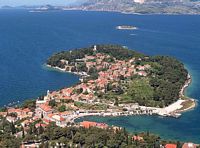 _small.jpg) Cavtat is a charming seaside resort, drowned in the trees; it is old Épidaure of the Greeks, thrives at the time Roman. Cavtat is a charming seaside resort, drowned in the trees; it is old Épidaure of the Greeks, thrives at the time Roman.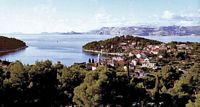 The little sister of Dubrovnik presents a very pleasant framework and calms. Besides its microclimate supports the presence of a subtropical vegetation. The little sister of Dubrovnik presents a very pleasant framework and calms. Besides its microclimate supports the presence of a subtropical vegetation.
Very popular under the domination Austro-Hungarian, it preserved an atmosphere of soft idleness, in the shade of immense palm trees which border its quays. It is today a charming seaside resort, whose architectural harmony was preserved. The hotel complexes for the majority are dissimulated under the pines. Cavtat is the capital of Konavle. |
|  Etymology Etymology | | Cavtat (to pronounce “tsavtate”): Italian: Ragusavecchia, Latin: Epidaurus, Greek: Επιδαυρος (Épidaure). The Epidaurus colony was re-elected by the Romans Civitas Vetus, the “old city”, which will give the name of Cavtat. |
|
| | _small.jpg) Cavtat is located in the municipality of Konavle, in the county of Dubrovnik-Neretva in Dalmatia, on the coast of the Adriatic Sea to 19 km in the south of Dubrovnik, in the extreme south of Croatia. Cavtat is located in the municipality of Konavle, in the county of Dubrovnik-Neretva in Dalmatia, on the coast of the Adriatic Sea to 19 km in the south of Dubrovnik, in the extreme south of Croatia.Cavtat is with 18 kilometers in the south-east of Dubrovnik, and to 5 km of the airport. 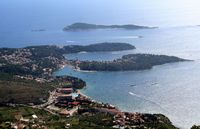 Cavtat is built on the peninsula of Rat (or peninsula Saint Roch) between two bays: Uvala Luka which separate it from the peninsula of Sustjepan (Saint Stephen), and Uvala Tiha in the North-East; these two very pleasant bays face the island of Supetar (Saint Peter). Cavtat is built on the peninsula of Rat (or peninsula Saint Roch) between two bays: Uvala Luka which separate it from the peninsula of Sustjepan (Saint Stephen), and Uvala Tiha in the North-East; these two very pleasant bays face the island of Supetar (Saint Peter).
_small.jpg) The road which skirts the steep coast from Dubrovnik spares superb panoramas on the closed city, but also on the islands, timbered and uninhabited. The road which skirts the steep coast from Dubrovnik spares superb panoramas on the closed city, but also on the islands, timbered and uninhabited.
|
|
| | | The city comprises many buildings of the time of the Republic of Raguse. This one made build the old city of Cavtat following the urban project which it had worked out. Most historic buildings belong to the Renaissance style, with traces of the Gothic style: Palace of the Vice-chancellor, fortifications, strengthened enclosure of the city, places, Saint Nicholas church, church Our-Lady-of-Snows and monastery of Franciscains. | _small.jpg) 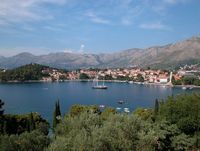 | 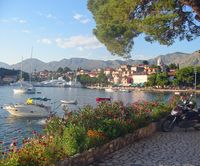 _small.jpg) 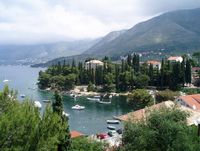 | | The Church Saint Nicholas (Crkva Svetog Nikole) | _small.jpg) At the beginning of the quays, the parish church Saint Nicholas, recognizable with its dome, is very photogenic, with its pretty square, its small garden, its presbytery baroque, its art gallery and its ex-votos gold and silver, left during centuries by grateful sailors. At the beginning of the quays, the parish church Saint Nicholas, recognizable with its dome, is very photogenic, with its pretty square, its small garden, its presbytery baroque, its art gallery and its ex-votos gold and silver, left during centuries by grateful sailors. | _small.jpg) _small.jpg) _small.jpg) | | The Palace of the Vice-chancellor (Knežev dvor) | | Located beside the Saint Nicholas church, the Palace of the Vice-chancellor (Knežev dvor) is a beautiful house of Renaissance style (16th century) contains some archaeological and ethnographic objects and a large table of Vlaho Bukovac, “the Carnival of Cavtat”. One finds in this museum the library and the archives of lawyer, writer and large collector of the 19th century Baltazar Bogišić, which bequeathed its heritage to the town of Cavtat. From June to October: 9:30 at 13:30. Addresses: Obala A. Starčeviča 18 Paying entry: 15 kunas. | | The Art gallery (Pinakoteka) | | The small museum of the Art gallery presents a collection of sacred art, of which beautiful icons and Italian paintings. Visit from June to October: the every day except Sunday, of 10:00 to 13:00 - better is worth to call before the visit. Paying entry: 10 kunas. When one climbs of the parish church, the art gallery is a little further, on the line. | | The House of Vlaho Bukovac (Vlaho Bukovac galerija) | | With the wire of the walk in the lanes in staircases of the city, one discovers pretty residences, the such native house of the painter Vlaho Bukovac (1855-1922), certainly the most influential painter in the realistic painting of 19th and 20th centuries in Croatia. The house of the painter became museum (and gallery of exposure), dedicated in memory of the prestigious child of the country; it contains a selection of its tables, in particular of the portraits. This museum is at the same time a workshop and a gallery presenting a large number of works of the artist, in a very sober space, favourable with contemplation. By restoring the house, one discovered, under the wallpaper, of splendid mural frescos with tons pastel, well far from tables academic loans of realism which decorate such an amount of theaters and museum of Croatia and Europe. Addresses: House of Vlaho Bukovac, ulica Bukovac 5. By borrowing the quay towards the line, until the lane, ulica Bukovčeva, to turn right. Visit: the every day except Monday, of 9:00 to 13:00, 16:00 to 20:00, Sunday of 16:00 to 20:00 Paying entry: 20 kunas. | | Peninsula of Sustjepan (Poluotok Sustjepan) | _small.jpg) | | The Port (Luka) | _small.jpg) _small.jpg) _small.jpg) | _small.jpg) _small.jpg) _small.jpg) | | The Bay of the Port (Uvala Luka) | _small.jpg) _small.jpg) _small.jpg) | | Peninsula of Rat or Saint Roch (Poluotok Rat) | | For the amateurs of walk, this projection of the ground, which divides bay into two long notches, and protects Cavtat in north is the ideal place. The vegetation is abundant there and of Mediterranean type. A way which leaves the Saint Nicholas church carries out until the top of Rat, where the cemetery is. | _small.jpg) _small.jpg) | | The Church Our-Lady-of-Snows (Gospa od snijega) | | At the end of the quay of Cavtat, between pines and palm trees, a small pointed bell-tower announces Our-Lady-of-Snows, the chapel of a Franciscan monastery built at the 15th century but several times altered since. The interior, which has the modern air rather, has two splendid specimens of sacred art: - the beautiful polyptique one of saint Michel by Vicko Dobričević (1510), where one sees, inter alia details, of deaths wisely expecting their judgment in their tomb (in bottom, in the center).
- a small Virgin with the Child (1494) richly framed.
One of works of the painter Vlaho Bukovac decorates the wall with the high altar of Our-Lady-of-Snows. It painted the sight there that one has, today, since the terrace of the hotel Croatia, the vegetation in less (the locality was extended much at the beginning of the 20th century than it is it now). | _small.jpg) _small.jpg) _small.jpg) | _small.jpg) _small.jpg) _small.jpg) | | The Cemetery Saint Roch | | Lanes in staircases lead to the peaceful cemetery of Cavtat; located at the top of the one of the hills which overhang the sea since the mount Saint Roch (Sveti Roko), the cemetery offers a splendid view-point with sight on the city, double bay, the mountain and the islands. To reach the cemetery, to circumvent the monastery of Franciscan by the line and to assemble the hill (10 to 15 min on foot). | _small.jpg) _small.jpg) _small.jpg) | _small.jpg) _small.jpg) _small.jpg) | | The Mausoleum of the Family Račić (Mauzolej obitelji Račić) | _small.jpg) In the middle of the cemetery, throne the mausoleum of a large family of ship-owners and bankers of Dubrovnik, the Račić family. In the middle of the cemetery, throne the mausoleum of a large family of ship-owners and bankers of Dubrovnik, the Račić family.The mausoleum is built out of white stones of Brać. This overhung octagonal structure of a dome is a work of art ordered with the famous Dalmatian sculptor Ivan Meštrovič by the rich family, and built of 1920 to 1922. One remains amazed by the astonishing mixture of the styles, sometimes Greek, sometimes Egyptian, always very pompous… Paying entry…: 5 kunas. | _small.jpg) _small.jpg) _small.jpg) | | While going down again of the cemetery, to follow the coastal path which leaves the monastery and makes it tower of the peninsula under the pines. | _small.jpg) _small.jpg) _small.jpg) | | The Bay of Tiha (Uvala Tiha) | | The bay of Tiha is bordered by large hotels such as Iberostar Albatros and Epidaurus. | _small.jpg) _small.jpg) _small.jpg) | _small.jpg) _small.jpg) | | The Chapel Saint George (Crkva Svetog Đurđe) | | According to its architectural elements this chapel goes back to the 15th century. | | The Island Saint Peter (Otok Supetar) | _small.jpg) |
|
| |  History History | | Built as of Antiquity on the peninsula of Rat (or Roch Saint), Cavtat occupied a paramount place in the history of the area. Founded by the Greeks, Cavtat was called then Epidaure, and, as in the homonymous city of Greece, one venerated there Esculape, god of medicine. Vestiges of the ancient city, amphoras of the time and remainders of Roman ships, always lie at the bottom of water. The Greek colony Epidaurus was conquered by the Romans into 228 before J. - C. The Roman colony left only the ruins of a theater and some tombs and flagstones engraved. At the beginning of christianization, Cavtat became the seat of the bishopric. The arrival of Slavic and Avars at the 7th century caused the decline of the city and the survivors took refuge on a rock small island called Laus close to the coast, to 20 km more in north to found Raguse, future Dubrovnik. The port and its locality were rebuilt with the Middle Ages in the same style as Dubrovnik, rising little by little with the second rank of the most important cities of the Republic of Raguse. At the 15th century, the republic of Dubrovnik buys old Epidaure and undertakes to strengthen it. It is the time when the city becomes a vacation resort snuffed by the families patricians of Dubrovnik. Of its past, it preserves an old palace of the Vice-chancellors and some residences patricians of the 15th century. |
|  Economy Economy | | For a few years, Cavtat has developed touristiquement. |
|
| | | Weather and forecasts | | | The Access by the Road | | Bus, line 10, every hour at the beginning of the bus station of Dubrovnik, stop with Mlini then Cavtat. | | The Access by Boat | _small.jpg) Cavtat is also reachable by boat into 30 min since the port of the old city of Dubrovnik. As the passages are ensured by small private boats, it is necessary to check the weather and the schedules. Cavtat is also reachable by boat into 30 min since the port of the old city of Dubrovnik. As the passages are ensured by small private boats, it is necessary to check the weather and the schedules.From May to September: 5 to 8 crossings per day. Price: 60/70 kunas for a return ticket. |
|  Visiting times Visiting times |
| |  Restaurants Restaurants | | Konoba Konavoski Komin | _small.jpg) With the development of tourism, about ten konobas family opened in the back-country of Cavtat. With the development of tourism, about ten konobas family opened in the back-country of Cavtat.A walk starts from Cavtat towards the heights of Čilipi, in full mountain, until the “konoba” (rustic inn serving as the traditional dishes) Konavoski Komin, where one prepares in particular famous “the meat under bell”, cooked on ashes, in a ground dish. One tastes there also the local orahovac (alcohol of nut) or of the maraskino, containing bitter morello cherries. |
|
| | |
|
 Situation
Situation Visits
Visits History, literature, arts, traditions, legends, religions, myths, symbols…
History, literature, arts, traditions, legends, religions, myths, symbols… Practical information
Practical information Other topics
Other topics
_small.jpg)

_small.jpg)

_small.jpg)
_small.jpg)


_small.jpg)

_small.jpg)
_small.jpg)
_small.jpg)
_small.jpg)
_small.jpg)
_small.jpg)
_small.jpg)
_small.jpg)
_small.jpg)
_small.jpg)
_small.jpg)
_small.jpg)
_small.jpg)
_small.jpg)
_small.jpg)
_small.jpg)
_small.jpg)
_small.jpg)
_small.jpg)
_small.jpg)
_small.jpg)
_small.jpg)
_small.jpg)
_small.jpg)
_small.jpg)
_small.jpg)
_small.jpg)
_small.jpg)
_small.jpg)
_small.jpg)
_small.jpg)
_small.jpg)
_small.jpg)
_small.jpg)
_small.jpg)
_small.jpg)
_small.jpg)
_small.jpg)
_small.jpg)
_small.jpg)
_small.jpg)
_small.jpg)
_small.jpg)
_small.jpg)